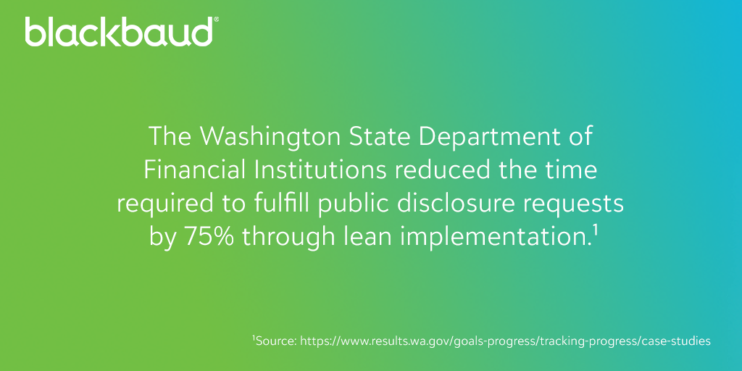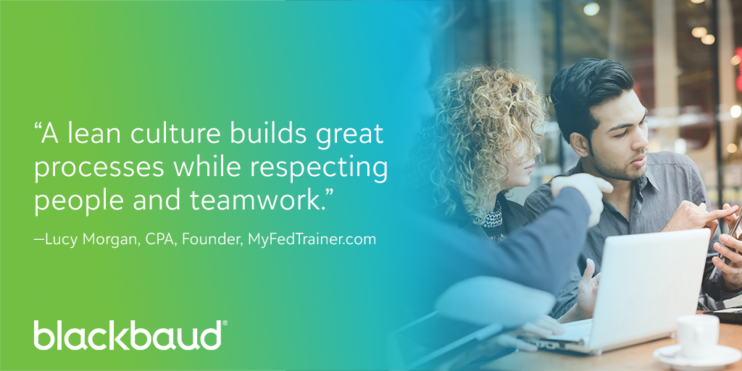7 Steps for a Successful Lean Implementation at your Nonprofit

From self-driving cars to artificial intelligence, we live in a period marked by rapid innovation and change. Now couple the accelerating pace of change with increasing pressures from funders to spend fewer dollars on overhead, and the fact becomes clear: we need to find new ways of doing things!
Efficiency Drives New Ways of Thinking
I wasn’t born an efficiency expert. When I was growing up in northern Minnesota, I didn’t see examples of organizational efficiency models, and I had never heard of lean concepts. But, having spent most of my career in manufacturing environments, I became aware of these concepts even before lean became the commonly used terminology.
However, when I moved into the nonprofit world, I experienced a paradigm shift. Lean is often thought of as a cost-cutting move for manufacturers. But with grant funding, there is no prize for cutting costs; the goal is to do exactly what you promised you’d do within the given budget. So, the concept of lean as a way to drive efficiency was slow to move into this environment.
But lean thinking eventually found its way into the public and social sectors about 10 years ago, where it has been successfully implemented by organizations such as the Environmental Protection Agency (EPA), Code for America, and the State of Washington.

What is Lean?
When we look at applying lean concepts in a service environment, our main goal isn’t to take the cost out of a product. Instead, we want to remove the waste out of a process. And the goal is not a dramatic 100% waste elimination in the future but instead a continuous improvement process of waste reduction starting today.
Lean supports clients through two core principles: increasing value and eliminating waste. The lean process is about reducing waste while increasing efficiency, productivity, and quality. The process is designed so we can do more of the things that clients value and less of the things that they don’t.
But if you don’t know who the client is, then you can’t determine which activities add value and which should be defined as waste. So, the first step in the lean journey is to identify the client.
Who Determines Value?
The client is not the next person in the process to whom you’re handing off the baton. The client is the person at the end of the process who benefits from the service you provide through your mission. This step of determining the primary client can be harder than you think, but it’s critical to the success of the entire process.
Once you’ve identified the client, you can then evaluate each step in the process to determine whether it adds value. If it doesn’t add value, then it’s waste and should be eliminated to the extent possible.
A common method used by organizations to organize the process steps is something called value stream mapping (VSM). If you’ve ever participated in a VSM exercise, you may recall organizing lots of sticky notes on a big sheet of paper or whiteboard.
The main benefit of VSM is that it gives you a full view of all the steps in a process, so you can more easily identify waste and form a plan to reduce it. With VSM, each step is reviewed based on these three criteria:
- Is this step something the client cares about or is affected by?
- Does this step change the product or service?
- Is this step done right the first time?
Once you’ve identified the waste, it’s time to remove as much of it as possible. Sound simple enough? Well, as Louis Pasteur said, “Fortune favors the prepared mind.” So, before you jump head first into your lean implementation project, let’s look at some steps you can take to ensure that you’re prepared for success.
7 Steps for a Successful Lean Implementation
- Create a compelling reason. There could be many reasons that your organization may choose to implement lean processes—to help more people, expand your mission, or get additional funding. Whatever the reason, keep in mind that people get behind big missions, so make sure your “why” is a big “why.”
- Dedicate adequate resources. Lean initiatives often get piled on top of people’s regular workload. If people are going to be involved in the lean initiative on a full-time basis, don’t expect them to do all their regular work as well.

- Educate staff and clients. A common failure of lean initiatives is that senior management assumes they already know what the customer thinks. But if you don’t talk to your clients, you can’t really know what things they value.
- Bite off what you can chew (not more). Lean is a continuous process of small wins. It’s not one enormous feat that you accomplish at the end of the year. So, make sure to consider what actions you can take to make processes better today, this week, or this month.
- Assign responsibilities. Be very clear about who is responsible for what and make sure that expectations are communicated to everyone involved in the lean initiative. But remember that lean is very much a bottom-up approach, so it’s crucial that people feel empowered to make improvements that make their jobs better.
- Plan/Do/Check/Act (PDCA). Part of building an innovative culture is letting people experiment. So, plan what you’re going to do, do it, then check to see if you get the result you wanted. If you see success, then you act on it. You don’t want to put something into practice without knowing that it will achieve the desired result. Checking results before you act allows you to ensure that you’ve worked out all the kinks before you implement change.
- Communicate Results. It’s critical that results are communicated, especially with lean initiatives. Communication is so much more than just a component of internal controls or a soft skill! Communication allows you to stop operating in secret. Poor communication is often a hallmark of a fear-based culture: we’re afraid we’re going to fail or look silly. But an important part of building a lean and innovative culture is failure because it tells you what needs to change.
Yes, efficiency drives new ways of thinking and acting! A successful lean implementation can open the door to greater efficiency, more empowered employees and service delivery that clients truly value.



